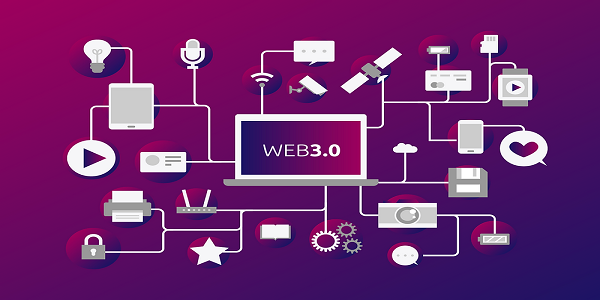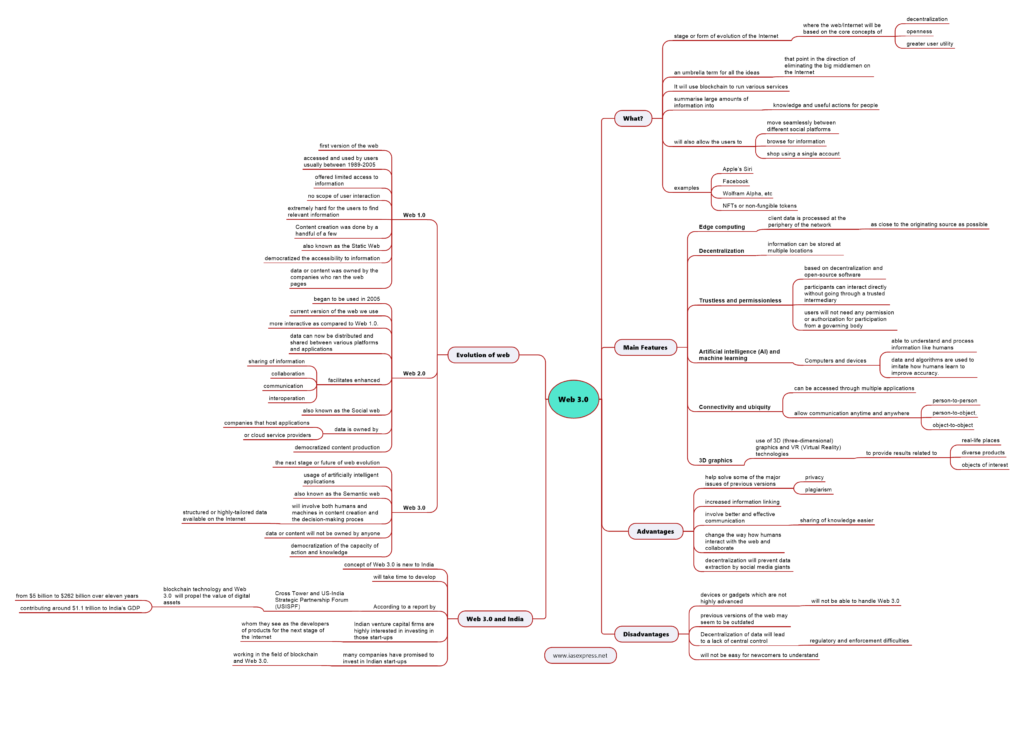Web 3.0 – Main Features, Advantages and Disadvantages

When things like metaverse, cryptocurrency and blockchain seem to be a way ahead in the field of technological innovation and advancement, Web 3.0 comes as a new concept raising curiosity among people. It is the subject of headlines for the past few months. While some call it the future of the Internet, others term it to be the decentralized version of the Internet. It would be interesting to know what is it and what is the buzz all about?

This topic of “Web 3.0 – Main Features, Advantages and Disadvantages” is important from the perspective of the UPSC IAS Examination, which falls under General Studies Portion.
What is Web 3.0?
- Web 3.0 is that stage or form of evolution of the Internet where the web/Internet will be based on the core concepts of decentralization, openness, and greater user utility.
- In other words, it is an umbrella term for all the ideas that point in the direction of eliminating the big middlemen on the Internet like Facebook, Google or Twitter and will allow the users to have more control over their data. It will use blockchain to run various services.
- It will also allow the users to move seamlessly between different social platforms, browse for information, or even shop using a single account.
- Some examples of the application of Web 3.0 include Apple’s Siri, Facebook, Wolfram Alpha, etc. that summarise large amounts of information into knowledge and useful actions for people.
- NFTs or non-fungible tokens, which are bought using crypto coins are also one of the best examples of Web 3.0.
Main features
- Edge computing
- Edge computing is a distributed information technology (IT) architecture in which client data is processed at the periphery of the network, as close to the originating source as possible.
- The traditional computing technology was based on centralized data centres and thus faced issues of bandwidth limitations, high latency and unpredictable network disruptions.
- However, in Web 3.0, edge computing will allow the data to spread out of the centre through using numerous devices spread across phones, computers, appliances, sensors and vehicles thus reducing the latency.
- Decentralization
- In Web 2.0, data is usually stored on a centralized or single server. However, in Web 3.0, information can be stored at multiple locations and hence, will be decentralized.
- In Web 2.0, social media giants like Google and Facebook hold massive databases related to users whereas Web 3.0 will allow users to have greater control over their data.
- Trustless and permissionless
- Web 3.0-being based on decentralization and open-source software will be trustless i.e., the network will allow participants to interact directly without going through a trusted intermediary.
- In addition, the users will not need any permission or authorization for participation from a governing body. This will make it permissionless.
- Artificial intelligence (AI) and machine learning
- Computers and devices in Web 3.0 will be able to understand and process information like humans. They will be able to do so through technologies based upon Semantic Web concepts and natural language processing.
- It will also involve machine learning (a component of Artificial Intelligence) where data and algorithms are used to imitate how humans learn to improve accuracy.
- Connectivity and ubiquity
- Information and content in Web 3.0 will be more connected and ubiquitous. This means data in Web 3.0 can be accessed through multiple applications.
- It will also allow person-to-person, person-to-object, and object-to-object communication anytime and anywhere. One of the best examples is the Internet of Things.
- 3D graphics
- Web 3.0 will also involve the use of 3D (three-dimensional) graphics and VR (Virtual Reality) technologies to provide results related to real-life places, diverse products, and objects of interest.
- The websites and service providers will extensively use three-dimensional images in online games, e-commerce, real-estate industry etc. to serve the purpose one aims for.
Evolution of web
The evolution of the web and its differentiation from its different versions are completely based on the tools and techniques they use at different times as they evolve. Based on these, the web we know can be classified into the following groups (as per its evolution).
- Web 1.0
- It was the first version of the web we use currently.
- This version was accessed and used by users usually between 1989-2005.
- It offered limited access to information with little or no scope of user interaction.
- This version did not have algorithms to sift through internet pages and thus it was extremely hard for the users to find relevant information.
- Content creation was done by a handful of a few.
- It is also known as the Static Web.
- It democratized the accessibility to information.
- However, the data or content was owned by the companies who ran the web pages.
- Web 2.0
- This version of the web began to be used in 2005. The current version of the web we use also belongs to this group.
- This is more interactive as compared to Web 1.0. This is because of the usage of advanced web technologies such as JavaScript, HTML5, CSS3, etc. which have helped in making this version interactive.
- This version has allowed both social networks and user-generated content production to flourish since data can now be distributed and shared between various platforms and applications.
- It facilitates sharing of information, collaboration, communication and interoperation in an enhanced way.
- The best specimens of this interactive web version are YouTube, Facebook, Twitter, etc.
- It is also known as the Social web.
- In this version, data is owned by companies that host applications or cloud service providers.
- It democratized content production.
- Web 3.0
- This version of the web can be considered as the next stage or future of web evolution.
- It will involve the usage of artificially intelligent applications having the ability to predict future trends, innovative web services and three-dimensional virtual worlds where one can interact as he/she does in real life.
- It is also known as the Semantic web.
- In the Semantic web, systems, people and home devices will interact amongst themselves automatically.
- As it will involve both humans and machines in content creation and the decision-making process, it will make structured or highly-tailored data available on the Internet.
- In this version, the data or content will not be owned by anyone.
- It involves the democratization of the capacity of action and knowledge.
Advantages of Web 3.0
- It will help solve some of the major issues of previous versions such as privacy, and plagiarism.
- It will allow increased information linking.
- It will facilitate web browsing by making it more accurate and efficient.
- It will involve better and effective communication making the sharing of knowledge easier.
- It will change the way how humans interact with the web and collaborate.
- As it will involve decentralization of data, it will prevent data extraction by social media giants that extract data without permission and practise exploitative advertising and marketing activities.
Disadvantages of Web 3.0
- Those devices or gadgets which are not highly advanced will not be able to handle Web 3.0.
- When people will get used to using Web 3.0, the previous versions of the web may seem to be outdated.
- Decentralization of data will lead to a lack of central control that will result in regulatory and enforcement difficulties in controlling cybercrime, hate speech and misinformation.
- Web 3.0 will not be easy for newcomers to understand.
Web 3.0 and India
- The idea or concept of Web 3.0 is new to India and will take time to develop. However, India is a part of discussions happening around it.
- According to a report by digital asset exchange Cross Tower and US-India Strategic Partnership Forum (USISPF), blockchain technology and Web 3.0 will propel the value of digital assets from $5 billion to $262 billion over eleven years contributing around $1.1 trillion to India’s GDP.
- Presently, Indian venture capital firms are highly interested in investing in those start-ups whom they see as the developers of products for the next stage of the Internet.
- Similarly, many companies have promised to invest in Indian start-ups working in the field of blockchain and Web 3.0.
- However, appropriate regulatory and legal frameworks would decide how far Web 3.0 becomes a success in India.
Conclusion
With time, the Internet has evolved a lot. Beginning from being less interactive to being more immersive, the Internet has been a game-changer for everyone. The evolution of the web has not only changed the global business and cultural landscape but also has hugely influenced the lives we lead now. However, only time will tell whether the buzz around Web 3.0 is reality or a mere assumption of how the web will evolve in future.
Practise Question
Q. What is the scope of Web 3.0 in India? Comment.
- https://www.investopedia.com/web-20-web-30-5208698
- https://www.moneycontrol.com/news/business/explained-all-you-need-to-know-about-web3-and-what-is-happening-in-india-7770581.html
- https://www.business-standard.com/podcast/technology/what-is-web-3-0-and-why-it-is-being-called-next-generation-internet-121122400057_1.html
- https://timesofindia.indiatimes.com/city/hyderabad/blockchain-web-3-0-to-power-indias-digital-asset-economy-says-report/articleshow/88131890.cms
- https://www.news18.com/news/tech/explained-what-is-web-3-0-and-why-does-it-matter-4625966.html
- https://economictimes.indiatimes.com/tech/startups/indian-vc-firms-betting-big-on-web-3-0-startups/articleshow/88148168.cms
- https://www.geeksforgeeks.org/advantages-and-disadvantages-of-web-3-0/
- https://www.aquare.la/en/web-3-0/
- https://www.eploy.co.uk/about-eploy/theblog/may-2012/the-evolution-of-web-technologies/
- https://www.eploy.co.uk/about-eploy/theblog/may-2012/the-evolution-of-web-technologies/
- https://www.sciencedirect.com/topics/computer-science/ubiquitous-network
- https://medium.com/fabric-ventures/what-is-web-3-0-why-it-matters-934eb07f3d2b

